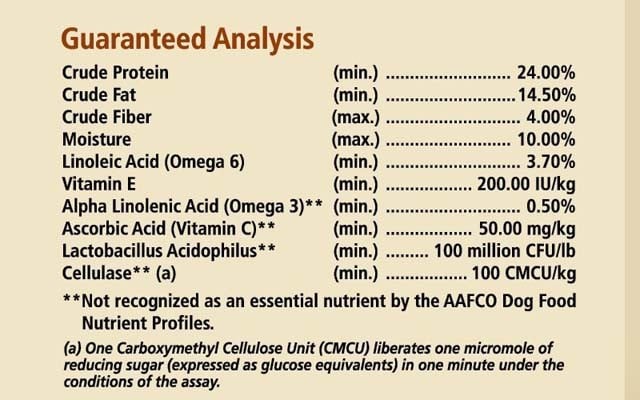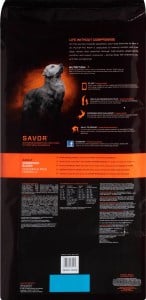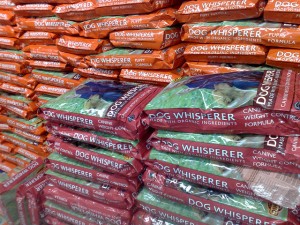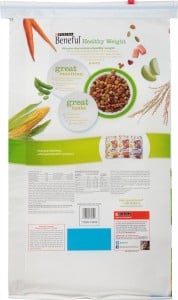
Table of Contents
As responsible dog parents, we want our pets to have the best of everything, and that usually starts with a proper canine diet. We try to make sure that our dogs are getting the most nutritious dog food for their age and activity level. To accomplish that, dog owners must know how to read dog food labels.
Reading labels on our own human food can become frustrating, but many believe dog food labels are even worse. That's not really the case, though. Dog food nutrition information labels themselves are almost identical to human food labels, but what confuses you is a set of different ingredients used in dog food.
How to read dog food labels
In order to learn how to read dog food labels, you need to know what type of stuff to expect and look out for.
Ingredients on dog food labels

Just like all the “people food” manufactured in the USA must contain labels with nutrition information on them according to law, the same applies to dog food labels – AAFCO and FDA require dog food manufacturers to list all the ingredients used in the product. This is your first point of contact to begin your research and learn how to read dog food labels, which can tell you a lot about what you're going to feed your dog.
Remember that no dog food brand can ever be better than its ingredients, so pay extra attention to everything on the list.
RELATED: Top 10 best dog food brands
The heaviest and most dominant ingredients are always listed first. The first few spots are usually taken by some type of meat, but you must also remember that many meat products are often mostly water. If you want a higher level of animal protein, look for a label that says *meat* meal, such as “Chicken Meal,” “Beef Meal,” or even “Bone Meal.” This type of dog food has most of the water removed, so the ratio of animal protein to liquid is much better.
Byproducts on dog food labels
Knowing how to also spot byproducts is important if you want to learn how to read dog food labels properly. However, note that not all byproducts in dog food are that bad, and in fact, some byproducts can even be good for your dog.
A lot of organ meat is very beneficial for your dog and is highly recommended to include in a regular diet. For example, the liver is a byproduct that has many vital nutrients in it, including vitamin A and iron. Other meat byproducts can contain bone, brain, blood, or stomach from animals. Previously discussed meat meals may also have a heart or tongue from the animal in them.
RELATED: Dog nutrition 101 – What do dogs eat?
While none of this sounds as mouth-watering to us, your dog would probably enjoy it all a whole lot and ask for more. Remember that just because you see the word “byproducts” on a dog food label, do not discount that food item. Of course, whether you avoid all byproducts completely or not is your choice.

Whenever you spot an item on the dog food label that piques your curiosity or, more importantly, worries you, make sure to research and learn what it is. It's not unusual for dog companies to cause health issues to dogs with some of the ingredients they choose to include in their products. If the internet doesn't help, don't be shy and consult with your veterinarian about whether you should be feeding your pooch that specific brand of dog food or simply switch to something less complicated.
Most vets agree that if a dog food label has the phrase “Balanced” or “Complete” on it, it's a good sign that your dog will get most of the ingredients he or she requires out of their kibble according to standard recommendations. You can always check AAFCO's dog food ingredient requirements to see if your chosen dog food brand meets their standards.
Preservatives on dog food labels

As you probably already know, preservatives are added to your dog's food to help it have a longer shelf life. Always check the “Best by” date of any dog food you are considering buying. If you purchase smaller packages of food for the dog, you may be able to buy a food item with fewer preservatives in it since your Fido will likely eat that kibble on the same day it arrives.
Being able to provide your canine with fresher dog food with fewer preservatives is not a bad idea at all.
When you're trying to understand how to read dog food labels and find a list of ingredients that typically sound like chemicals, these are usually the infamous preservatives in your dog's food. High fructose corn syrup is one that is often recognized because it is used in human food, too. US laws require dog food manufacturers to list all of the preservatives they use in their products. However, if they use ingredients that are processed somewhere else, they do not always list those preservatives.
RELATED: How to feed dogs?
Many dog owners will avoid any pet foods that contain BHA, BHT, or ethoxyquin on their dog food labels. These are preservatives to keep the fat in the dog food from turning rancid, but scientists have questioned whether these are really safe for canines to eat. Currently, the FDA believes they are safe for use in dog food products, but many people refuse to purchase food with those ingredients.
Many of these concerns over the above byproducts in dog foods came about after owners noticed reproductive problems, skin allergies, and even cancer in dogs with high levels of these chemicals in their systems. More studies are still needed to draw a definite conclusion on how these items affect dogs and whether they should be withdrawn from being used in dog food manufacturing.
Some manufacturers of dog food products have begun using vitamins E and C as well as plants such as rosemary as preservatives in their dog foods. Products with such types of natural or semi-natural preservatives are supposedly better for your pooch, but they will not last as long as ones with chemicals, so be sure to only purchase what your dog can eat before the “Best by” date.
Your dog's nutritional requirements

Each stage of a dog's life – from puppy to adult dog to senior dog – will have its own nutritional needs. The Association of American Feed Control Officials (AAFCO) has provided the nutrients that dogs need every day.
When you are trying to learn how to read dog food labels, remember to always look for the AAFCO rating for that specific dog food item. A food label should say that it contains a balanced diet according to AAFCO's standards.
RELATED: Where to find free dog food samples?
When you are purchasing food for your dog, think about your pooch's age as you read your dog's food labels. If you have a puppy, look for dog food brands that state they are suitable for puppies, growing dogs, for growth, or all life stages. If your Fido is an adult, dog food that says it is for adults, adult maintenance, or all life stages will be best.
Unfortunately, for whatever reason, the AAFCO does not provide any dog food ratings or analysis for elderly dogs. But rest assured, their nutritional needs are definitely different. You can talk to your vet about the best type of dog food for a senior dog if you have one, or check for legit online resources that provide more information on this subject.
Here's a good source: Your Dog's Nutritional Needs: A Science-Based Guide for Pet Owners
Natural and organic dog foods
At the time of this writing, no law is required, and there are no ethical standards for dog food manufacturers who label their products “Organic” to be able to prove that that particular brand is actually made out of 100% organic ingredients. Therefore, whenever you see a dog food product labeled as such, it is likely a sales gimmick to attract pet parents who only want the best for their fur babies.

It could indeed be a completely organic item, but it most likely isn't. Always research further to ensure that you're buying exactly what you think you are buying.
Dog foods that carry the “All Natural” labels or stickers should have very few synthetic ingredients in them. However, similarly to organic dog foods, there is very little regulation on how many synthetic products can be included and still be called natural.
When it comes to dog food, “natural,” “human-grade,” and “organic” ingredients, more often than not, will be used as a marketing ploy to attract more buyers, mostly because nobody requires these companies to provide any proof. Very often, these dog food products are also more expensive, but honestly, they offer very little for that added expense.
Laws around dog food labels and the area concerning “natural, organic, human-grade” gimmicks, in particular, are still very loose, but hopefully, this will change soon. With the expansion of the dog food business and the pet industry, the government will soon take a closer look at what dog food companies are selling to our pets. Learning how to read dog food labels isn't that difficult, and it's almost the same as reading labels on human foods.
Disclosure: We may earn affiliate commissions at no cost to you from the links on this page. This did not affect our assessment of products. Read more here and find full disclosure here.












